Science
(www.olympiadsuccess.com)
Chapter 12: Reproduction in Plants
Class VII
Multiple Choice Questions
Question 1
Which of the following parts of a plant take part in sexual reproduction?
(i) Flower
(ii) Seed
(iii) Fruit
(iv) Branch
Choose the correct answer from below.
(a) (i) and (ii) (b) (i), (ii) and (iii)
(c) (iii) and (iv) (d) (ii), (iii) and (iv)
Answer 1
(b)
Question 2
Lila observed that a pond with clear water was covered up with a green algae within a week. By which method of reproduction did the algae spread so rapidly?
(a) Budding
(b) Sexual reproduction
(c) Fragmentation
(d) Pollination
Answer 2
(c)
Question 3
Seeds of drumstick and maple are carried to long distances by wind because they possess
(a) winged seeds
(b) large and hairy seeds
(c) long and ridged fruits
(d) spiny seeds
Answer 3
(a)
Question 4
The ‘eye’ of the potato plant is what
(a) the root is to any plant.
(b) the bud is to a flower.
(c) the bud is to Bryophyllum leaf.
(d) the anther is to stamen.
Answer 4
(c)
Question 5
The ovaries of different flowers may contain
(a) only one ovule
(b) many ovules
(c) one to many ovules
(d) only two ovules
Answer 5
(c)
Question 6
Which of the following statements is/are true for sexual reproduction in plants?
(i) Plants are obtained from seeds.
(ii) Two plants are always essential.
(iii) Fertilisation can occur only after pollination.
(iv) Only insects are agents of pollination.
Choose from the options given below.
(a) (i) and (iii) (b) (i) only
(c) (ii) and (iii) (d) (i) and (iv)
Answer 6
(a)
Question 7
Pollination refers to the
(a) transfer of pollen from anther to ovary.
(b) transfer of male gametes from anther to stigma.
(c) transfer of pollen from anther to stigma.
(d) transfer of pollen from anther to ovule.
Answer 7
(c)
Very Short Answer Questions
Question 8
Fungus, moss and fern reproduce by a common method of asexual reproduction. Name the method.
Answer 8
They can reproduce asexually by means of spore formation.
Question 9
Pick the odd one out from the following on the basis of mode of reproduction and give reason for it.
Sugarcane, Potato, Rice, Rose
Answer 9
Rice, as it does not reproduce by vegetative propagation whereas the other three plants do.
Question 10
Boojho had the following parts of a rose plant – a leaf, roots, a branch, a flower, a bud and pollen grains. Which of them can be used to grow a new rose plant?
Answer 10
Branch.
Question 11
Which type of pollination does the Figure 12.1 indicate?

Answer 11
It shows self pollination.
Question 12
One morning as Paheli strolled in her garden she noticed many small plants which were not there a week ago. She wondered where they had come from as nobody had planted them there. Explain the reason for the growth of these plants.
Answer 12
The seeds from the tree may have fallen below and germinated into small plants.
Short Answer Questions
Question 13
In the diagram given in Figure 12.2 label the parts marked (a), (b) and (c).
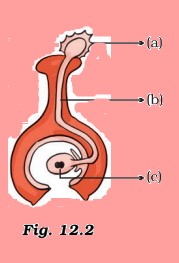
Answer 13
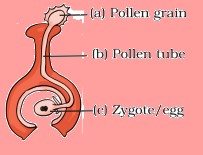
Question 14
When you keep food items like bread and fruits outside for a long time especially during the rainy season, you will observe a cottony growth on them.
(a) What is this growth called?
(b) How does the growth take place?
Answer 14
(a) It is bread mould, a fungus.
(b) They develop from spores.
Question 15
Group the seeds given in Figure12.3 (i) to (iii) according to their means of dispersion.
(a) Seed dispersed by wind
(b) Seed dispersed by water
(c) Seed dispersed by animal
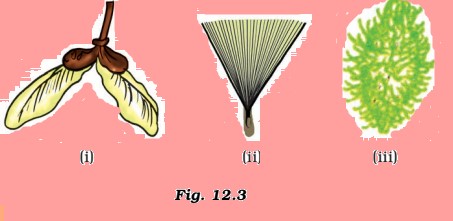
Answer 15
(i) to (ii) are dispersed by wind;
(iii) is dispersed by animal.
Question 16
Coconut is a large and heavy fruit. How is it adapted for dispersal by water?
Answer 16
Coconut fruit has spongy fibers, which helps it to float in water.
Long Answer Questions
Question 17
In the figure of a flower given in Figure 12.4, label the parts whose functions are given below and give their names.
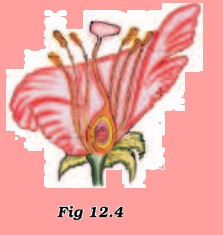
(a) The part which contains pollen grains.
(b) The part where the female gamete is formed.
(c) The female reproductive part where pollen grains germinate.
(d) The colourful part of flower which attracts insects.
Answer 17
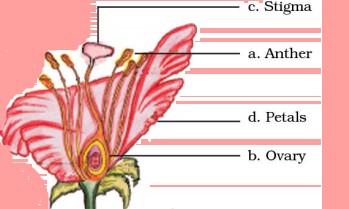
Question 18
Fill in the blanks with correct terms.
The male and female gametes fuse to form a _____(a)______during the process of _____(b)______. This grows into an _____(c)______ which is enclosed within a seed. After fertilisation the ovules develop into _____(d)______ and the ovary develops into a _____(e)______ .
Answer 18
(a) zygote (b) fertilization (c) embryo (d) seed (e) fruit
Question 19
In the diagram of a bisexual flower given as Figure 12.5, draw the missing part and label the parts marked (a), (b) and (c). Also label the missing part that you draw.
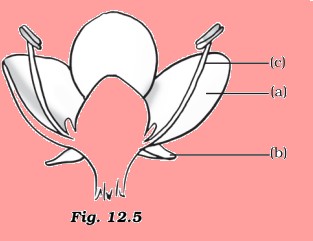
Answer 19
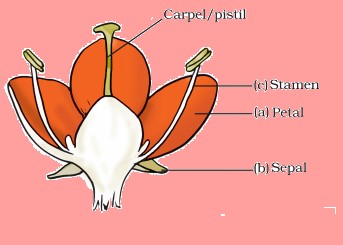
Question 20
Write how the following seeds are dispersed.
(a) Seeds with wings.
(b) Small and light seeds.
(c) Seeds with spines/hooks.
Answer 20
(a) dispersed by wind.
(b) dispersed by wind .
(c) dispersed by animal.
Yearlong program for Olympiads preparation & to build necessary skills for future.
Explore More
Time to mark your calendar with the upcoming Olympiads exam schedule.
Explore More
Take your Olympiad preparation to next-level by taking LIVE Classes.
Explore More
Assess your performance by taking topic-wise and full length mock tests.
Explore More
Online tuitions for international compeitions like SASMO, SEAMO, etc for Grades 1-11.
Explore More